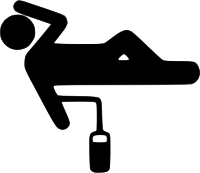
Photo from wikipedia
Objective: The hydraulic properties of implantable rotary blood pumps (RBPs) determine their interaction with the cardiovascular system. A systematic comparison in this regard has not yet been performed for different… Click to show full abstract
Objective: The hydraulic properties of implantable rotary blood pumps (RBPs) determine their interaction with the cardiovascular system. A systematic comparison in this regard has not yet been performed for different clinically used RBPs. The aim of this study is to describe the hydraulic characteristics of four RBPs with a universal mathematical model and to compare their behavior under clinical operating conditions. Methods: First, static and dynamic pump properties of four RBPs (HVAD, Heartmate II, Heartmate 3, and Incor) including their peripheral components were identified in an in vitro setup; results were translated into mathematical models based on principles of turbomachinery including the low and backflow regions. Second, the four hydraulic models were compared in a numerical simulation of the cardiovascular system for full- and partial-support conditions. Results: A model structure applicable to each of the investigated RBPs was developed. Deviations between simulated and measured signals for static and dynamic properties were small (2.6 ± 0.5 mmHg, 0.38 ± 0.14 L/min, respectively). For a simulated partial support condition, flow pulsatility ranged from 4.1 (Incor) to 9.1 L/min (HVAD). Negative flow rates during diastole were observed in three out of four pumps. Conclusion: Hydraulic properties differ greatly between the investigated RBPs, with flat characteristics for the HVAD and Heartmate II and steeper curves for the Heartmate 3 and especially the Incor. Significance: Hydraulic characteristics of implantable RBPs are particularly important at lower pump flow rates if backflow is to be avoided. For further research, we provide dynamic hydraulic models of the four RBPs including their periphery.
Journal Title: IEEE Transactions on Biomedical Engineering
Year Published: 2019
Link to full text (if available)
Share on Social Media: Sign Up to like & get
recommendations!